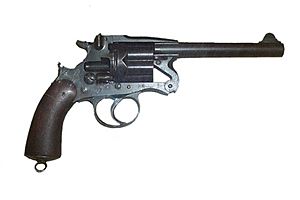Enfield revolver facts for kids
Quick facts for kids Enfield Mk II Revolver |
|
|---|---|
 |
|
| Type | Service revolver |
| Place of origin | United Kingdom |
| Service history | |
| In service | 1880–1911 |
| Used by | United Kingdom & Colonies |
| Wars | First Boer War North-West Rebellion Second Boer War Boxer Rebellion First World War |
| Production history | |
| Designer | RSAF Enfield |
| Designed | 1879 |
| Manufacturer | RSAF Enfield |
| Produced | 1880 – 1889 |
| Specifications | |
| Length | 11.5 in (292 mm) |
| Barrel length | 5.75 in (146 mm) |
|
|
|
| Cartridge | .476" Revolver Mk II |
| Calibre | .476 Enfield |
| Action | Double-action revolver |
| Rate of fire | 18 rounds/minute |
| Muzzle velocity | 600 ft/s |
| Effective firing range | 25 yd (22 m) |
| Maximum firing range | 200 yd |
| Feed system | 6-round cylinder |
| Sights | fixed front post and rear notch |
The Enfield Revolver was a special type of handgun made in Britain. It was designed and built by the government's own factory in a town called Enfield. This revolver first used a large bullet size called .476 calibre.
These revolvers, known as the Enfield Mk I and Mk II, became the official sidearm (a small gun carried by soldiers) for the British Army. They were also used by the North-West Mounted Police in Canada. Many other units across the British Empire also used them. It's important to know that the term "Enfield Revolver" does not include the Webley Mk VI revolvers that were made by the Enfield factory later on.
The Enfield No. 2 is a different type of revolver. It uses a smaller .38 calibre bullet. This gun was the main sidearm for British and Commonwealth forces during World War II.
Contents
Understanding the Enfield Mk I and Mk II Revolvers
The first versions of the Enfield revolver were the Mark I and Mark II. The Mark I came out around 1880 and the Mark II around 1882. These revolvers were the official military sidearms for Britain from 1880 to 1887.
A Look at the .476 Enfield Cartridge
The Enfield Mk I and Mk II revolvers used a special bullet called the .476 Enfield cartridge. This bullet weighed about 265 grains and was loaded with 18 grains of black powder. However, during the Afghan War and other conflicts, this cartridge was found to be not powerful enough. Soldiers felt it lacked the "stopping power" needed for military use at that time.
How the Enfield Revolver Worked
The Enfield Mk I and Mk II revolvers had a special way of unloading. Unlike many other revolvers where all spent cartridges would fall out easily, the Enfield had a complex system. This system was supposed to let the user remove only the empty bullet cases, while keeping any unused bullets in the cylinder.
The revolver had a hinged frame. When the barrel was unlatched, the cylinder would move forward. This action would push out the empty cases, allowing them to fall away. The design was meant to prevent live, longer bullets from falling out at the same time.
However, this system was not very good. It was difficult to unload, and you had to reload one bullet at a time through a small gate on the side. The revolver was also clumsy to use. It often jammed when trying to remove the empty cartridges. Because of these problems, the Enfield Mk I and Mk II revolvers were never very popular. They were eventually replaced in 1889 by the Webley Mk I revolver.
Enfield Revolver in Service
The Enfield revolver was used by various military and police forces. It played a role in several conflicts during its service period.
The Enfield Mk. II with Canadian Police
The Enfield Mk. II was the official sidearm for the North-West Mounted Police (NWMP) in Canada. They used it from 1883 until 1911. The NWMP Commissioner, Acheson G. Irvine, first ordered 200 Mark II revolvers in 1882. They arrived in Canada in December of that year. These new revolvers replaced an older model called the Adams.
Commissioner Irvine liked the revolvers so much that he ordered another 600. These were delivered in September 1885. His replacement, Lawrence W. Herchmer, reported that the police force was fully equipped with Enfields. In total, 1,079 Enfields were provided to the NWMP. Herchmer was happy with the revolvers but was concerned that the .476 round might be too powerful.
The first batch of revolvers was stamped with "NWMP-CANADA" and an issue number. Later orders did not have this stamping. These revolvers could be fired in either single-action or double-action mode. They also had lanyard rings, which allowed them to be tied to a uniform so they wouldn't be lost.
Over time, some parts of the revolvers would wear out. Worn parts could cause problems with ejecting empty cases or make the barrel loose, leading to less accurate shots. Complaints about the revolvers started as early as 1887. This was partly because the British military was switching to Webley revolvers. By 1896, issues like hinge wear and loose barrels were common.
Starting in late 1904, the Mark II began to be replaced. The .45 calibre Colt New Service revolver became the new standard. However, the Enfield continued to be used by the NWMP until 1911.

